#Isometric Game Community
Explore tagged Tumblr posts
Video
youtube
Back Cover to AI Art S3E42 - Crusader No Remorse
Older video games were notorious for back cover descriptions that have nothing to do with the game so let's see what a text-to-image generator makes of these descriptions. each episode of Back Cover to AI Art Season 3 will feature 4 ai art creations for each game.
1. Intro - 00:00 2. Back Cover and Text Description - 00:10 3. Creation 1 - 00:30 4. Creation 2 - 01:00 5. Creation 3 - 01:30 6. Creation 4 - 02:00 7. Outro – 02:30
Crusader No Remorse (Commodore 64) Crusader: No Remorse is a 1995 isometric shooter that immerses players in a dystopian future dominated by the World Economic Consortium (WEC). Players take on the role of a "Silencer," an elite soldier tasked with hunting down the Resistance, a group of rebels opposing the WEC. However, after a betrayal during a routine mission leaves the protagonist as the sole survivor, they realize that the WEC is not what it seems and must ally with the very rebels they were sent to eliminate.
🤖🔫💥💣🕵️♂️🤖🔫💥💣🕵️♂️🤖🔫💥💣🕵️♂️🤖🔫💥💣🕵️♂️🤖🔫💥💣🕵️♂️
The gameplay features a combination of intense action and strategic exploration, allowing players to perform acrobatic manoeuvres such as rolling, jumping, and kneeling. A diverse arsenal of weapons is available, from standard firearms to experimental armaments like microwave cannons and EMP dischargers. Players face off against a range of WEC forces, from guards to powerful mech units, while navigating intricate levels filled with traps, security systems, and puzzles that require careful exploration and problem-solving.
🤖🔫💥💣🕵️♂️🤖🔫💥💣🕵️♂️🤖🔫💥💣🕵️♂️🤖🔫💥💣🕵️♂️🤖🔫💥💣🕵️♂️
For more Back Cover to AI Art videos check out these playlists
Season 1 of Back Cover to AI Art https://www.youtube.com/playlist?list=PLFJOZYl1h1CGhd82prEQGWAVxY3wuQlx3
Season 2 of Back Cover to AI Art https://www.youtube.com/playlist?list=PLFJOZYl1h1CEdLNgql_n-7b20wZwo_yAD
Season 3 of Back Cover to AI Art https://www.youtube.com/playlist?list=PLFJOZYl1h1CHAkMAVlNiJUFVkQMeFUeTX
#youtube#back cover#back cover to ai art#ai#ai art#aiart#ai art community#ai generated#gaming#video games#commodore 64#crusader no remorse#isometric shooter#wec#digital art#generative ai#s3e42#ai art video series#youtube series#ai art generation
0 notes
Text
figured out how to modify + repackage existing zt1 mods to match stats for similar objects in-game and have them still run lmao
#the model work on these is impeccable and they fit so seamlessly into the game#that being said the stats for restaurants/amusement is either over or under powered compared to vanilla counterparts#idk i already know the game strats and i just wanted more buildings to choose from for the hashtag aesthetic#i should figure out how to do these isometric model sprites so i can give back to this community lmao#the modding community is so small that its one forum and your account has to be individually approved when you sign up#so the least i could do after signing up and downloading DOZENS of mods would be to upload a few#when making mods i mostly like to make qol tweaks to vanilla so thats probably what i'd do#theres a lot of incomplete themes in this game that would be fun if they weren't like 2 buildings total
1 note
·
View note
Note
What’s Fallout like? Like I know I can google what kind of game it is but more than that what games would you compare it to? and is it more story-based or gameplay-based?
That's a difficult one to answer and I'm not sure I have the authority to do it lol
But I'll try!
The Fallout fandom is fairly complicated due to the IP being passed around and the lore/values of its storytelling being muddied over the years. That being said I think both old-school and new fans would still agree that the story is the most important element, as they're meant to be role playing games where you make decisions on often heavy matters (especially in the games of the original devs).
Fallout 1 and 2 are turn-based isometric rpg-s from the late 90s. If you like that type of gameplay, they're fantastic games and cult classics. They don't shy away from heavy themes.
Then the IP got sold to Bethesda and their version of Fallout is a FPS/TPS action experience, as seen in Fallout 3 and 4. The combat is fun but even the newest game is shit by shooter standards. If you played an Elder Scrolls game (like Skyrim), they're like that but set in a retro futuristic post apocalypse. A large slice of the fandom has only played these ones and skipped the original turn-based games.
Fallout New Vegas was made by the original team but using Bethesda's engine. Many fans would tell you that out of the modern titles, that's the one with the best writing.
Fallout 4 was a very popular title due to the scrap and build system. As you adventure, you can scavenge all sorts of trash and then build your own little settlements in the wasteland and populate them with settlers. Add mods to that, and the community really did some magic. It made people connect with the world of Fallout on a personal level.
The story in a nutshell: in an alternate timeline, survivors of a devastating nuclear war are trying to rebuild and make the irradiated wasteland of the United States liveable again but every group and faction has a different take on how society should be rebuilt. When the writing is done well, your choices have weight and it's impossible to be fair and please everyone. You get to discover a variety of different factors that lead to the Great War and you have to wager whether humanity is doomed to make the same mistakes all over again. Is there a way to avoid them? What kind of sacrifices does that require? Etc.
A lot of it is supposed to be a critical look at war, 50s Americana and the dangers of nationalism, rampant consumerism, xenophobia, etc.
Hope this helped a little! It's difficult to find two Fallout fans who are on the exact same opinion of all the games. I personally think, the fun part of the games is when you get to carve a little slice out of the wasteland for yourself and your community and the stimulating part is the overarching story and lore.
It's no wonder the original writers made The Outer Worlds too, which I don't consider a legendary game but the similarities are obvious in the themes.
#ive been told the Wasteland series is similar to the og games#i got then but havent had the chance to play them yet#personal#text#Fallout
205 notes
·
View notes
Text
Evolution of Homestuck’s Art Style, Pages 1-1550

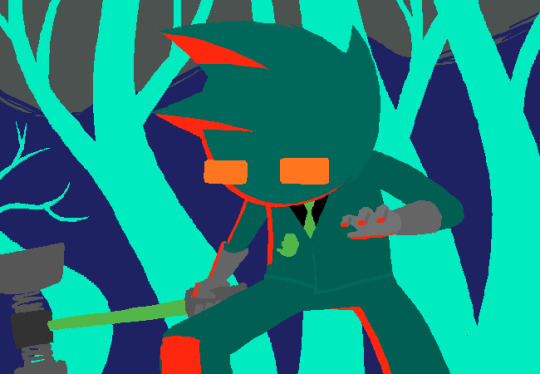
[page 1, 1434]
Since Act 4 began, I’ve been blown away by the visual difference between this and the earlier comic – there’s been a big shift in style, and huge increase in the use of color. So, re-reading and just looking at the art style, here’s an overview of the changes so far.
[a short one – 2.8k words below the cut + some very beautiful panels. I was limited to 30 images in a post, so would recommend looking up page references for the ones tumblr wouldn't let me include <3]

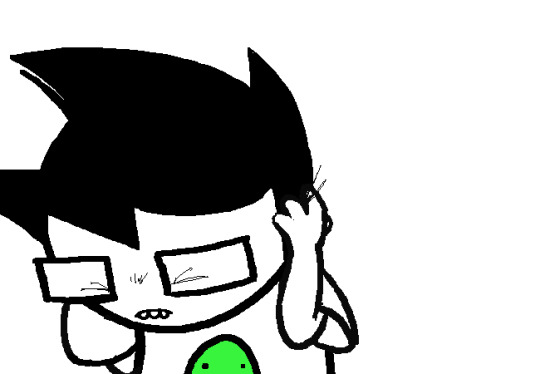
[page 4, 16]
Act 1 mostly uses sprite art and clean, tidy images; the white background is the dominant color in most panels. Where John is drawn freehand, he’s drawn as close to his sprite as possible, with a thick black outline and blocky shapes. This is often done to give him a more complex pose or facial expression than a sprite would allow (for example, p.16). John’s house is relatively tidy, filled with discrete items that it’s easy to move around and manipulate to create new panels – these are mostly either imported photographs rendered in black and white, or line drawings similar to John’s sprite. Occasional items are drawn in color – some due to their importance (Sburb logos) but some due more to common sense (blood capsules).
John’s captchalogue and strife systems are colored overlays on panels that are still mostly black and white. Full color panels show up when John (or Rose) uses a computer, showing their desktop background, or when John looks or goes outside and observes his neighborhood. Here, his near monochrome, thick-lined sprite stands out against the lineless background (the car and mailbox help soften this for now).


[page 195, 246]
Over the next few acts, Homestuck will develop an art style typified by its lack of outlines and straights, abundance of curves and swirls, use of patterned blocks of solid color to create light and depth effects, and emphasis on motion. Act 1 has the earliest steps towards this – my favorite is page 195, where John looks through his telescope and sees the meteor heading towards him. These styles of sky, clouds, wind, and small animated elements that don’t dominate the panel are all still common techniques in Act 4. The final shot of the meteor cloud in the End of Act 1 flash animation (p.246) – which is almost entirely full color outdoors shots – is another great example.
Act 1 is definitely not dull or colorless, and there's a real charm to its style, but it is overall functional. Panels are designed to give information, show the results of commands, and communicate a change of state from the previous panel – it’s unlikely someone would look at them just for aesthetic value. Act 1 has the closest to an ‘adventure game’ look, as lots of John’s items look like they should be clicked on for more information, and rooms are often rendered in an isometric style. In a narrative comic, this also makes John feel boxed in and stifled by the imposing walls and lack of color. His world is stark, monotonous, and cut-and-paste, somewhere he has been placed instead of somewhere he naturally belongs.


[page 312, 363]
Act 2 stays primarily monochrome, but panels are busier on average. Dave’s room (p.312) has so much going on in comparison to John’s (p.4) that in a video game, it’d be hard to know what to click on first. John’s room has become much busier now that it’s been looted and smeared by imps, which makes it harder to keep the art consistent between different panels and angles. Like John and Rose, Dave’s computer, house exterior, and inventory systems are shown in color. Dave’s living room is monochrome but has a fair amount of color through his brothers’ puppets, while John’s now has imps in harlequin outfits, build grist, and Nannasprite.
Rose is unique among the kids for never being placed on a white background. When she’s first introduced, her room is shown in pale gray to indicate that it’s getting dark in her house. This color is unobtrusive, close to white, and doesn’t feel like it makes the panels more complex. As a wildfire creeps closer, the sky around Rose tints red – a slight burgundy on page 398, and a more dangerous wine red on page 985. The mausoleum is also gray, with a soft lineless background unlike other indoor spaces. Rose is the first beta kid to leave her house entirely and go to a secondary location, heading down to the Skaianet Laboratory on page 840 – a much more visually complex area in which she’s shown against a green background until she goes back to the fire. If there’s any examples of her in a white space, I missed them!
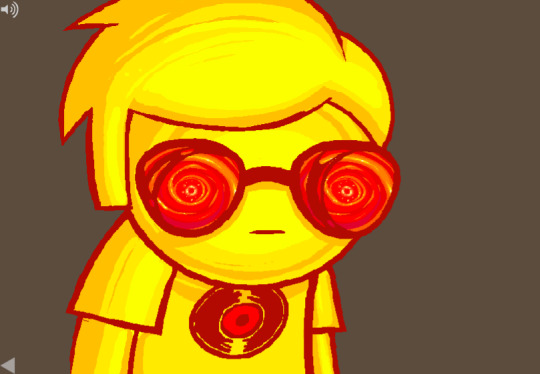

[page 444, 665]
The kids are still drawn close to their sprite style, with occasional variation. Dave’s sprite is shaded in red and yellow on page 444 to represent the ‘sick heat’ he’s trapped in, and he’s shown in red silhouette as he steps onto the roof on page 665. In ‘WV: Ascend’ (p.757), every frame is full color and more detailed than most previous panels, and the kids’ and guardians’ sprites stand out as the only cut and pasted element. The landscapes are changing faster than the characters, which creates a feeling of unfamiliarity and their struggle to keep up with their new circumstances.

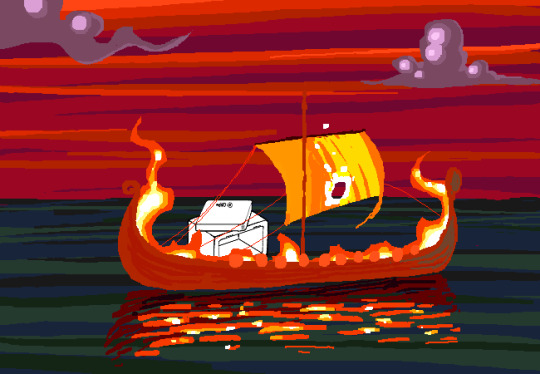
[page 248, 558]
The Wayward Vagabond’s panels immediately look different from the kids’. Page 248 is easily the most complex still image up to that point, with the greatest color diversity (four shades in the sky, one in the city, and I think as many as eight in the sand). It’s very different from the blocky blue sky at John’s house. WV has a sprite too, but his is full color, meaning that when he’s drawn freehand he’s drawn without an outline. This makes him feel ‘part’ of the background instead of pasted on top of it, merged with his landscape while the kids are at odds with theirs. The 100-page Wayward Vagabond point of view section is the first extended sequence of full color panels, but by this point they’ve shown up enough that it doesn’t feel jarring.
Act 2 has the first panel where the art itself blows me away. Page 558, with its fiery boat sailing into the sunset, goes harder than any panel that’s come before it entirely in service of the Vaulthalla pun.


[page 760, 840]
Act 3 introduces Jade in the typical sprite style and monochrome interior, but she appears in her windowed garden atrium, so at least half of her first panel is in full color. The exterior of her house is more colorful and prominent than any kid before her, with various colors of clouds and plants; the same is true of her computer, which surrounds her in three-dimensional spinning colors instead of being a two-dimensional screen. Jade’s room is the biggest and messiest yet, as in just two acts the comic is already feeling limited by its ‘character stuck in a room’ format.
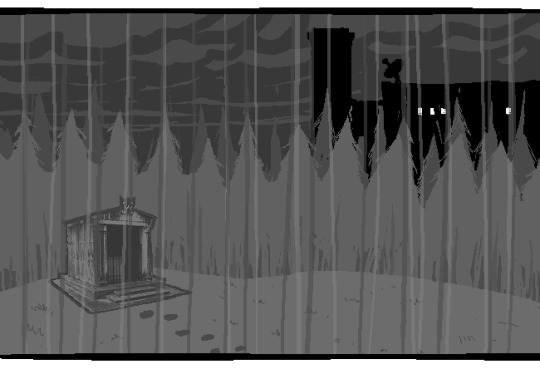
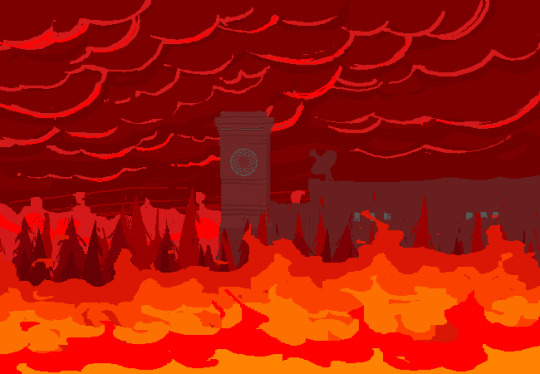
[page 225, 986]
This act shows the art style in transition, with even more color and complexity introduced into what are technically indoor panels of the kids, and more excuses found to draw in the softer, lineless style. On page 840, the tunnel Rose walks through is sketched like a sky, when an act earlier it might have been made of simpler, blockier shapes. Page 986 shows a very similar view to page 225, and the new version isn't necessarily more complex but it is more Homestuck, with increased texture and definition in the clouds and a fire moving through layered lines of color.
Just like in Act 2, ‘Years in the future…’ pages lead the charge with the changing art style. Pages 924, 1005 and 1035 provide lush post-apocalyptic landscapes with a beauty that isn’t seen on present-day Earth – even Jade’s island on page 1080, clearly designed to be visually interesting, doesn’t have quite the liveliness and definition of the post-apocalyptic pages (in my opinion).


[page 1051, 1147]
Act 3 also introduces the aesthetic vertical page. Previously, vertical pages are used occasionally for their aspect ratio, showing a book or the entirety of John’s house. Page 1051’s art isn’t giving information or showing a changed state, but stands out as an impressive visual and a pause for breath in between panels that do give information. Page 1147 is similar, and I believe it’s also the first time a beta kid is drawn in the lineless style (with detail to their form, not just a silhouette). This page comes right before the end of act flash, showing the final form the art has now achieved.
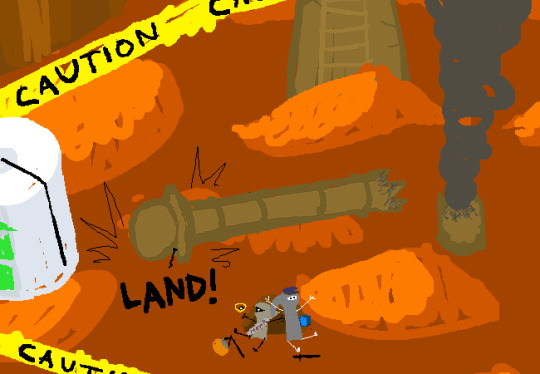

[page
Besides the monochrome sprite art associated with the kids’ houses and the lineless style associated with the outdoors, Act 3 introduces a couple more styles. One is the scribble style, first introduced with WV’s Can Town fantasies and murals, and then scattered throughout Jade and the exiles’ scenes in Act 3. Some panels in this style are explicitly intended to be drawn or imagined by an in-universe character, while other times they represent a strong emotion or sudden interruption.
The other new style is the color-adjusted jpeg, seen in Prospit (p.1029) and the dark kingdom (p.886), where the background is composed of externally-sourced images that have been manipulated and recolored. The over-saturation of a single color makes the location recognizable without need for its own distinctive art style – Prospit is entirely gold or yellow, the dark kingdom is entirely purple, and the Felt’s mansion is entirely green.
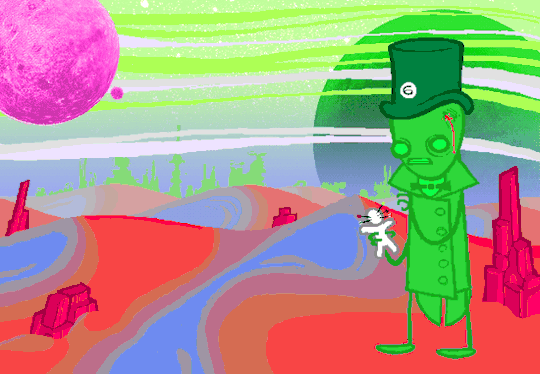

[page 1236, 1337]
The Intermission is made almost exclusively in this style, which adds a lot of detail to backgrounds while sacrificing some distinctiveness. While sprite art is used, the sprites themselves are entirely black or green, so they complement their environment the same way John complements his Act 1 house. By using images of a mansion’s interior as panel backgrounds, the Intermission is arguably more ‘realistic-looking’ than the representational art and medieval castles of the Acts, which ties into its grittier and more grounded tone.
With its goal of a fast production pace in advance of a more complex Act 4, there aren’t many artistic standout pages in the Intermission. A rare exception are the pre-city wasteland panels, such as page 1236, which blend the jpeg technique (for the stars and planets) with a lineless alien landscape of pleasantly rolling dunes. Pages 1188 and 1337 also blend these styles, but this is the extent of the lineless panels until Slick enters the safe.

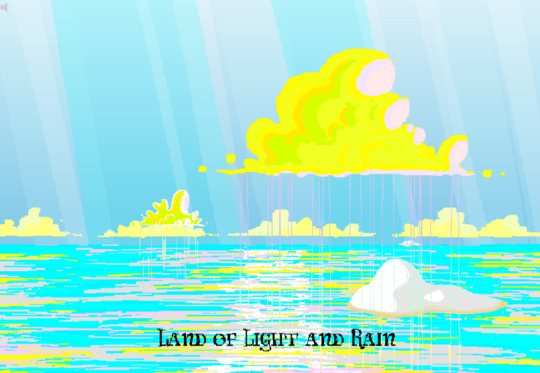
[page 1358, 1407]
Act 4 introduces the Land of Wind and Shade (LOWAS) and the Land of Light and Rain (LOLAR), two planets with distinct designs in the lineless style where John and Rose’s scenes now exclusively take place. Both are stunning – LOWAS is mostly dark blue with gray clouds, and a focus on bioluminescence through its mushrooms and fireflies, while LOLAR is mostly white landmasses amid a sea of pastel blue, pink and yellow. Since Act 1, Homestuck has taken care to set its animated pages primarily outside the kids’ houses, with the notable exception of page 253’s walkaround. This is likely because color makes flash pages more interesting to watch and easier to interpret – but character or plot developments have still been the focus. Page 1407, which introduces LOLAR, is the first flash with a primarily aesthetic function.
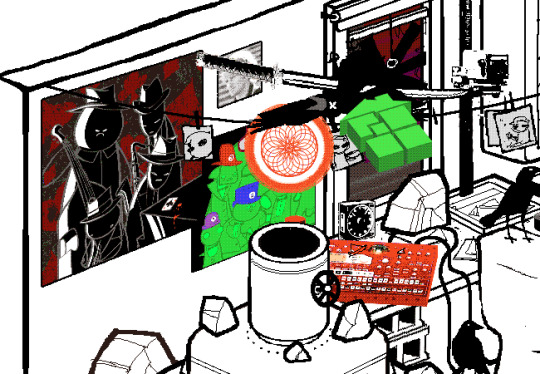

[page 1446, 1457]
In Act 4, panels that might have been standouts in previous acts are now commonplace, such as John answering messages on page 1391-2. Use of brown and yellow keeps the exiles’ pages visually distinct from John and Rose’s, but they’re no longer a clear upgrade. This helps the comic skip back and forth between John, Rose and the exiles without a narrative transition, as the art change is less jarring. Pages that take place in Dave’s monochrome room are now the outliers, while Rose and John’s sprites (and Dad’s car) really feel like relics of previous acts. Even with John’s new full-color suit and Rose’s land including a lot of white, their stark lines and lack of shading don’t merge well with their landscapes and always become the focal point when these sprites are used.
As such, there’s more examples of John and Rose in a lineless style, which feels long overdue and catches them up with changes that have already happened. Fully lineless panels tend to be very well composed with clear artistic intent; easy to interpret and pleasing to look at. They often represent movement even when not animated, so work well for transitioning to or away from a character. Sprite panels, on the other hand, have much lazier composition. Messes don’t get cleaned up, and panels show irrelevant objects often half-inside the panel and half-outside, so even when they’re communicating clearly they’re often less pleasant to look at – I find this true of AR’s introduction in Act 3 (p.1100-1111) and all the Dave and Jade scenes in Act 4. Page 1446, for example, features the first prototyping of Dave’s sprite, but it’s hard to focus on the crow-sword’s move through the room with so much else in the way (in contrast with page 185, where the harlequin doll is clearly in focus for its prototyping).


[page 39, 1523]
As a final comparison to illustrate this change, let’s look at page 39 side by side with page 1523. In both cases, a character is typing in Pesterchum. The reader has already seen the kid’s location and nearby possessions, so the images do nothing more than illustrate that the character is on their computer, while the meat of the page is in the Pesterlog.
On page 39, this is situated between two John panels where he takes different actions (assigns Hammerkind and captchalogues a book), so page 39’s image feels necessary to the sequence. On page 1523, this is immediately followed up by another image of Rose, still on her computer, and one that feels far more dynamic. Rose gets a facial expression and sitting position that give her some character, the close-up shot feels intimate for an important conversation, and the background is still present through the ocean behind Rose and the shading from her umbrella. So while there’s nothing wrong with page 1523 (which does successfully re-establish Rose after some pages away from her) or with the sprite style in general, the upgrades to other areas of the art do make the sprite pages feel weaker by comparison.
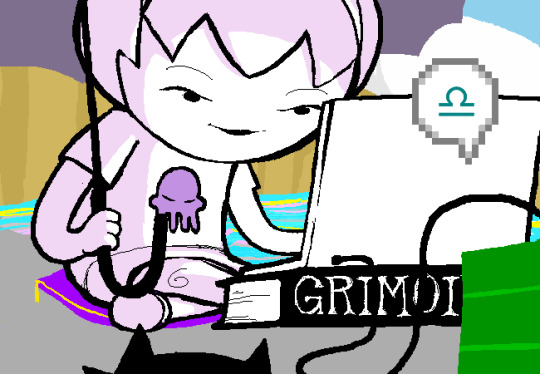
[page 1524]
Whether intended or otherwise, the kids’ houses being the only monochrome, heavily outlined spaces while all other locations are full color and mostly lineless, is really evocative of the comic’s title. The first full-color panel is John’s desktop on page 24 featuring the Slimer background he made himself, and later his computer becomes a gateway to the Medium where he can access a whole world of color designed just for him. In contrast to being ‘stuck’ in defined dimensions and copied images, the kids are entering a world of beauty, motion and art for its own sake. The exiles’ panels introducing the lineless style and the kids’ following reflects the exiles guiding the kids into the Medium and towards their eventual quests. LOWAS and LOLAR’s fantastical designs add a sense of magic to the story, bringing it away from games and technology and towards more esoteric, unknowable forces. Their unique designs compared to the kids’ similar-styled houses recalls Rose and gallowsCalibrator’s mentions of Sburb’s ‘flexible mythological framework’ (p.440) or ‘HYP3R FL3XIBL3 MYTHOLOGY’ (p.1524), which apparently extends to the level of art style.
Personally, I think the swirling, lineless art style Homestuck has developed is very pretty, but does take away the ‘point and click game’ feeling of Act 1. It’s interesting that the art style develops alongside the reader-command format – Act 1 is almost entirely reader commands, while Acts 2 and 3 mix reader commands with author-driven exile commands and ==> pages, and Act 4 has already seen the reader suggestion boxes close for good. I think the question of ‘is Homestuck a game?’ is still relevant, but needs a different answer in Act 4 compared to Act 1. The level design of LOWAS, LOLAR, Prospit and the dark kingdom is excellent, but they’re for running around and fighting, not standing still and clicking. The genre has changed, and the characters’ roles in the game are being reconfigured alongside the players’ and narrators’ roles.
So, how will Homestuck’s art develop from here? My guess is that there will be a decrease in GIFs and an increase in still images, as the new style is likely harder to animate and better at conveying motion without animation. Act 4 is setting up to bring Dave and Jade into the Medium as quickly as possible, at which point there will be five planets (including post-apocalyptic Earth) each with their own distinctive designs. Once this happens, there will be no need for scenes inside the kids’ houses, and the comic will be able to eliminate the kids’ sprites altogether (or at least re-design them with more color and fewer stark lines, more similar to the trolls’, exiles’ or Felt members’ sprites). Dave and Jade’s sprites being prototyped may further affect the Medium, perhaps affecting the light and dark kingdoms as planets as well as just their agents. Finally, I think there will be a focus on how the kids’ actions physically change the landscape of their planets, as this has already been the case with their modifications to their houses.
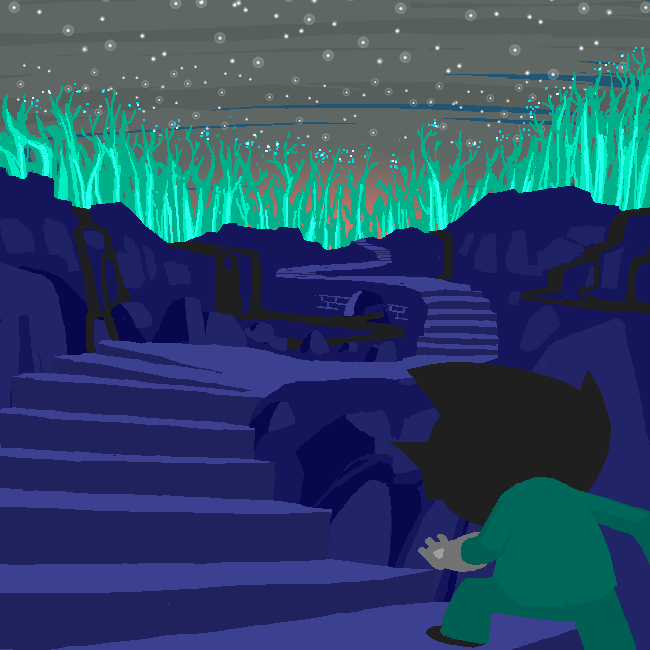
[page 1395]
#homestuck#analysis#i like to look at it! it's a beautiful comic there's a whole bunch of panels id get framed for my wall#if i had money or a house!#act 3 also doesn't have a super defined identity so thinking abt it as a transitional act for the art is cool to me#also wish id thought a lil more abt facial expressions and emotions and how they are represented in sprites#but im trying to keep posts short and simple and not let them get away from me. so. i will stop here <3#chrono
22 notes
·
View notes
Text
401% FUNDED | ONLY 5 DAYS TO GO!!
Field Agent Handbooks: Observancy Dept. 1924–28
Sharpen your ESP skills and seek out suspicious activity as a pendulum-dowsing Field Agent
This set of four Field Agent Handbooks are an always-on solo RPG/LARP to play with when out and about. They’re created as in-world artefacts from the 1920s, made for you to note your observations about the world around you through a lens of suspicion.

1924 – Revolution
We suspect the animal kingdom of plotting a revolution and you are here to help us understand their devices.
Our mission in the Observancy Department is to spot any such behaviour or signs of suspicious activity, note them down, and draw our conclusions.
Additional pages include:
Blank map with grid references
Table of potential signs of revolutionary activity
List of weather types and symbols for notation

1925 – Leviathan
The age of flight may still be in its infancy but we have heard worrying reports from our aeroplane and dirigible pilots of glimpses of giant beasts roaming the aether, just out of sight.
Our fresh mission is to observe the clouds, look for unusual shadows & formations, and attempt to discern the activity and anatomy of these sky-bound leviathan.
Additional pages include:
Common anatomy of leviathan (hypothesised)
Illustrated chart with types of clouds and symbols for notation
Illustrated chart for estimating distance to horizon
Table to identify the Beaufort Number for the wind
List of weather types and symbols for notation
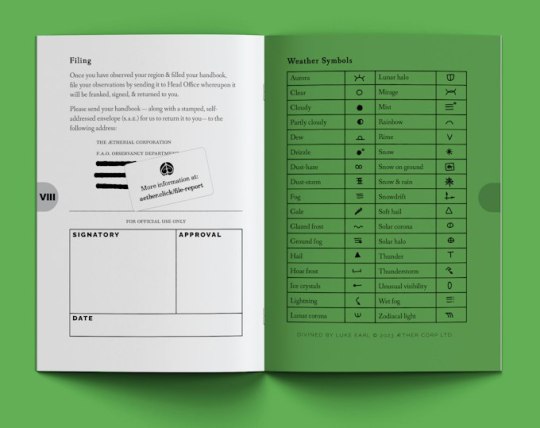
1926 – Communication
While we looked upward, we didn't think to concern ourselves with the growing cacophony in our very own gardens, forests, and fields.
Our mission turns to our leafy neighbours to see if we can understand their speech and intuit their meaning throughout each season.
Additional pages include:
Signs and shapes to look out for
Size estimation chart
List of weather types and symbols for notation

1928 – Giants
From the landscape sprung the flowers, but who formed the landscape? Newly uncovered texts indicate the folklore might be true and giants may have indeed roamed and shaped the earth.
Our mission is to lower our gaze to the ground to identify oddly shaped mounds, mimetoliths (rocks resembling faces), gouged earth, and suspicious urban planning decisions. Under the hills there may be sleeping colossus.
Additional pages include:
Signs to look out for
Common rock types
How to draw landforms & rocks in an isometric fashion

I wanted to shine a light on this project because I met Luke at Dragonmeet in December '23 and fell in love with the way he thinks about RPGs, graphic design and play/ritual/thinking-the-world in his games!
I can't recommend this project enough and I've been waiting excitedly to support it and see it succeed! It really represents everything I think is special about RPGs and the things I also want to explore in this design space *and art movement* and if you have any interest in TTRPGs beyond the scope of dungeon games, Luke is making some of the freshest and most evocative design you can find in the entire medium.
Everything you see here is directly from the kickstarter. Go back it! I promise you'll be glad you did, there are few more unique and inspiring things you could spend your money on in TTRPGs right now!
#ZiMo#zine month#zinequest#indie ttrpg#ttrpg#tabletop#ttrpg design#ttrpg recs#ttrpg dev#tabletop roleplaying#tabletop games#ttrpg community#kickstarter#solo rpg#ttrpg stuff#larp#game design#roleplaying#aethercorp
49 notes
·
View notes
Text
Video Game of the Day: Project Zomboid
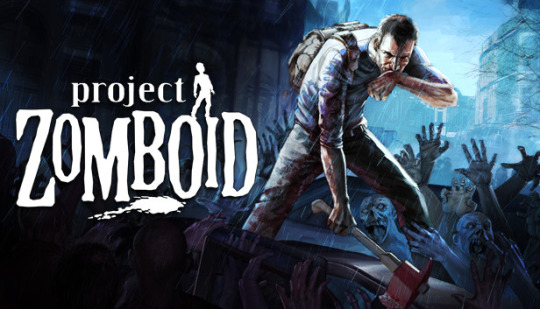
Project Zomboid is a difficult and realistic isometric zombie survival game developed by British-Canadian indie dev team, Indie Stone. In Project Zomboid you are not truly expected to survive, but simply prolong the life of your quite customizable playable characters in poly-graphics.
The game is incredibly difficult and detailed. There's a massive modding community too.

Don't forget the ability to play in both multiplayer in solo.
Gameplay takes place in Kentucky USA. The main aspects to know when playing is
Once bitten you're infected, no cure, no options (expect for that amputation mod)
You can wear anything and everything you find
Beware that time is passing. Winter is coming.
This is how you die
19 notes
·
View notes
Text
feelin rlly idk HAPPY?? over this franchise as a whole✨
I wasn't even alive for Fallout 1 & 2 - but upon entering the world 3 years after they were released, would grow up hearing its name constantly... never did i think it would take GTA's place as my favourite video game series. Like literally never thought the weird little isometric game talked about by my older cousins would be the one.
I played Fallout 3 at the worst period of my life- it became a pure escape from graduating high school, becoming a severe alcoholic and moving off my mountain into my province's capital city. I was in love with it to the point that when I came home to my family home to visit, I would haul my xbox 360 in my backpack and strap my little tv to my back with a rope- ✨that's✨ how addicted I was to it.
It resonated with me in a way no other game series has. No, I obviously didn't grow up in the same standards as the wastes, but could resonate with foraging for food, no clean water & mess, destruction and despair everywhere you turned.
Fast forward a year or so, and I try Fallout: New Vegas. This is where it finally became my favorite series ever. I could list all the reasons, but they're similar to what you'll see all over the net; it's just amazing. I already was all "fuck the government" since I was a child but it made me think- think about the rule of authority, think about perseverance, weigh out what "right" and "wrong" truly means and the blurred line between the two.
By the time I was 21, I tried Fallout 4. It took some getting used to in the terms of its modern graphics, but I really loved how I got to experience conversations that felt like I was actually having them. I loved building the world back up and when I was brave enough to try mods- then shit got real interesting. I was already obsessed with Fallout 3 & NV but we can thank Fallout 4 for getting me into the community as a whole.
I was one of the ones to make fun of FO76- the launch was a huge part of that, but I just didn't understand how it could ever truly fit into the Fallout series. I played it for the first time when I was 2022, and now after 2 years I wholeheartedly regret shitting on it so hard. There are so many cool quests/stories and though some of them are silly seeing as it's online-based and they need to cater to that and though it's a bit strange at first, it feels so cool to be around other players adventuring the wastes + actually having to persist to build your own base, feed yourself and survive- as console commands don't exist in the same realm they used to with the earlier titles.
Now, we arrive at the airing of the first Fallout television show. I seriously thought it was gonna be shit- I just couldn't imagine them being able to do a good job but as we can see, here we are. The show is amazing and I didn't even know it was something I wanted so badly. The only real-life renditions of Fallout I've seen is that one live action trailer for 76 + cosplay- so seeing it in film, is seriously so fucking cool.
Idk guess im just gettin a little ✨sentimental✨ towards a series that has given me so many lessons, so much ability to cope with my own shit + gotten me into such a fun community filled with funny jokes, amazing art, discussions and rich lore that maybe one day could leave the video game + TV screen and become even a book.
Ty to the crew of original artists who started this back in the 90s, and thank you to the crew of artists at Bethesda in this current century who kept this game going💖
#fallout#fallout series#fallout amazon#fallout tv series#fo4#fo76#fo3#fnv#bethesda game studios#bethesda#fallout prime#fallout 4#fallout 76#fallout 3#piqttextpost
23 notes
·
View notes
Text
This week’s post comes late because I had to deal with some annoying tonsillitis at the end of the previous week, and after three days of feeling well, I got the flu.
I guess that looking back at the previous months, this year has been much difficult regarding sickness. I have experienced a streak of four out of five months getting some kind of mild illness. Probably my immunity is low, maybe is the wear and tear of a body that has been homesick for years, or maybe it's the world situation, the uncertainty, the global outlook, which, without a community, looks pretty bleak (that is one of the reasons why this year I plan to return to my country, to return to the communities with which I maintain tides, to create more communities, to carve out a space for action in the city, so as not to feel stagnant, paralyzed, and hopefully, create life in the voids left by a system that in many respects does not seem to work).
So today I just wanted to share with you some of the things that have given me joy this month, things that have helped me feel better about the world, things that have helped me have fun, or things that have inspired me in some way.
Probably, I will try to make one of these posts monthly.
As in a previous post, I already talked about “The Dawn of Everything: A new history of humanity” by David Graeber and David Wengrow, and how this book has influenced my worldbuilding (and my vision of history and society in general), I’m tagging that post as the first “Monthly recommendations”, making this the second entry in an effort to share the things I have read, played with, listened to, or watched.
So let’s begin, today I will start easy with only two recommendations:
“Black Leopard, Red Wolf” by Marlon James
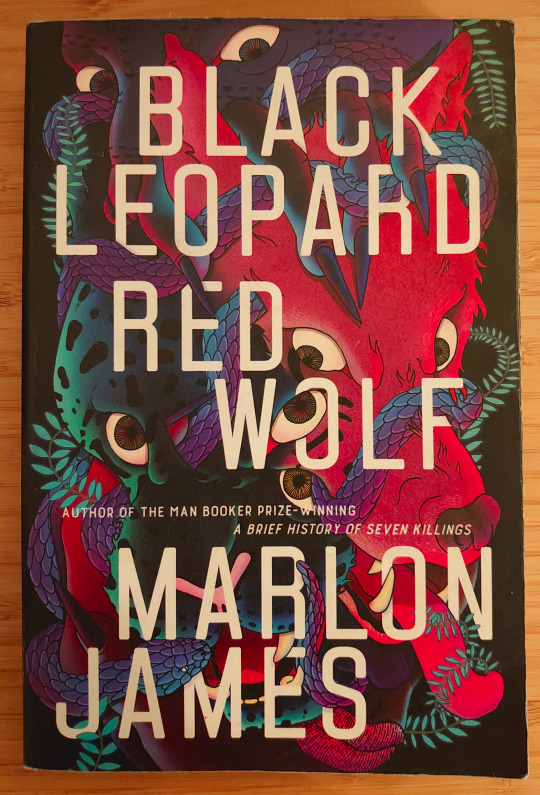
This is a little of a cheating, because I read it some months ago, but I returned to it again as I started to read the second volume of this trilogy.
But in any case, I wanted to leave it here as a recommendation, as in it I found a voice that helped me feel excited about fantasy again.
The book is written following the tale of an unreliable narrator, and the language that he uses is very particular, is feral, is fast, is emotional, and the way the words flow give as many weight to whom this character is, and how the world around him behaves, as the things he say.
The world on this book has drawn from African history and mythology, and I think that the prose in it helps a lot to make this world feel distinctive.
Some weeks ago I read a post (that I haven’t been able to find again) of someone talking about the future of sword and sorcery as a genre and, in some ways, I feel that this book hits a lot of the emotions that ones feel when reading sword and sorcery books, while bringing with it a lot more. It is a beautiful, non-eurocentric world with powerful prose and mesmerizing imagery. Be warned, however, that there are scenes of considerable violence, which are not recommended for all readers.
"Drova - Forsaken Kin" by Just 2D

This is an isometric pixel RPG action game, influenced by classics like “Gothic”, and is inspired by Celtic mythology.
What I loved about this game is the feeling of discovery and the way it plunges you into the world without any guidance (don’t expect to have a “live map” or any kind of guide for the quests). Here, every letter that you find, every crafting material that you collect, every person to whom you talk, every item, feels special because there is no easy way to know what or whom is more important to your goals; the only way is to interact with the game.
In respect to mechanics, I loved how the designers included some very simple particular mechanics or procedures that make the game feel more diverse, and when you find each one of these mechanics, it feels like a discovery.
Although the narrative is simple, I felt the world was beautiful, it has some magical moments and a constant underlying sense of how magic is tied to nature, how divinity is nature, which really makes the end of the game feel special.
.....................
I hope these two small recommendations inspire you, or at least give you some fun. Next week, I expect to return for the tables of the travel procedure for “No Peace for the Heathen”.
#books#fantasy novel#games#fantasy#ttrpg community#sword and sorcery#tabletop role playing game#indie ttrpg#roleplaying game#blog
3 notes
·
View notes
Text


Batman (ZX Spectrum)
Developed/Published by: Jon Ritman, Bernie Drummond / Ocean Software Released: 05/1986 Completed: 01/04/2025 Completion: Finished it. God help me I finished it.
It all seemed so simple.
Jon Ritman and Bernie Drummond’s “Head Over Heels” is a big video game (or should I say, computer game) in the personal history of Mathew; bought because it was so lauded in the likes of Amstrad Action, it really did blow me away once I played it: a true adventure featuring two protagonists with different abilities that you have to use together. It seemed like a work of genius to me.
So when I was looking over 1986’s releases, I noticed the pair’s previous isometric action adventure, Batman, and thought it might make sense to play. See if the magic of Head Over Heels was there from the beginning, and set the table for a replay of Head Over Heels at some point in the future.
I’d consider Batman a bit of a joke in the non-UK gaming community, probably because anyone who is looking up Batman video games is going to discover that the first Batman game is a ZX Spectrum release that features Batman wandering around an isometric, bizarrely decorated Batcave looking for parts of the “Batcraft” where the enemies look like melted dogs and basically touching anything kills you. It’s just so weird, lol!!!
What’s generally forgotten in the discussion is that in the mid-1980s, no one gave a fuck about Batman. It had been nearly twenty years since the TV show and Wikipedia notes that even Batman comics circulation had reached an “all time low” by 1985. His fortunes would turn around rapidly–The Dark Knight Returns would actually start being published before Ritman and Drummond’s Batman would come out–but considering the era, from Ocean’s perspective it will have been an opportunistic gamble: grab a cheap license on death’s door and try and squeeze some more juice out of it. And they did give it to one of their best developers, who’d already given them a lot of success with the Match Day franchise. Clearly it wouldn’t matter too much that he could barely remember who Batman was…
Anyway–I’m just going to cut to the chase here and say that this took me about six months to finish, and as a result I’ve lost most of the specific game history I’d dug up about it and all that remains is a lot of vague “I read somewhere that Ritman said…”. So don’t quote me on anything but my memory is that Ritman has been quoted as saying that he wanted to best Knight Lore, and then Drummond came in and started drawing like a cyclops head with flippers and he was like “alright!”
Knowing this, I should probably have played Knight Lore first, but getting into Rare’s entire back catalogue would be a whole other thing, so I can just say that even with a prior understanding of the isometric action adventure, Batman is a brutal experience.
First things first: it’s really hard to parse visually on the original ZX Spectrum. The environments are surprisingly detailed, but because it’s all in monochrome, it’s really quite hard to discern what everything is, and no way to tell what’s going to kill you when you touch it. I had hopes that the Amstrad CPC version with its wider range of colours might fix that, but there’s no consistency from room to room so it sort of just looks insane.
If you want to play this in 2025 with normal human eyes, there’s a fantastic remake by Retrospec (that’s, er, fifteen years old itself), or you can go back and play “Watman” a DOS remake from 2000 (so closer to the release of the original than now.) However if you’re really determined to play this (which I don’t recommend) what I recommend is to play the MSX2 remake. It’s pretty much what you’d imagine the ZX Spectrum original to be if it had full color–right down to the performance.
And, of course, then you get the ability to quicksave and load, because without that I’d have never been able to finish this in a million years.

The version I played looked like this. Significantly easier to parse.
It’s not simply that Batman is full of things that kill you. It’s that the game is designed to force you to play perfectly from the first screen. Enemies seem to have a truly random movement routine (hope you love shuffling around waiting for them to select a direction away from you) but that’s not an issue as much as that there’s no leeway in the collision detection, and in fact the game is designed around that, generally requiring that if you want to make a jump you actually have to position Batman so he’s got about one pixel left on the platform he’s “standing on” so you can reach the next. Hilariously, the manual makes excuses for this:
“To make certain jumps it is necessary to hang by the ‘merest thread’ on the edge of the Carbon Re-inforced Batcloak - you may need practice to perfect this feature!”
(This isn’t even the funniest excuse in the manual, which also notes “The Joker and the Riddler do not appear ‘in person’ in the game, as Batman is all too familiar with their image. The henchmen they have selected are unfamiliar to Batman and this further complicates his task.”)
So yes, the game is exacting. And with 150 rooms to explore, it’s also bloody confusing. It’s actually not as non-linear as you might think–a lot of directions you go don’t really head anywhere–but once you get deeper into the game your head will spin, and every game over feels like being kicked full in the groin when you realise how difficult it’s going to be to get back to where you were (although the game features a save system of sorts based on when you pick up particular collectibles, it’s unforgiving at best.)
And on top of all that, the puzzles are intense. I will have to go back to Knight Lore to see just how complicated things are there, but it’s a bit like when you go back and look at things like Wizardry or The Bard’s Tale. You’d expect that these genre originators would be simple, but somehow they’re significantly more complicated and off-putting.
Here, you can sense Ritman almost understanding how to provide an on-ramp for players as the game is designed that you first collect Batman’s gear, slowly growing his abilities as you go (you can’t even jump at first) in a smaller section of the map that’s particularly linear. But one of the very first puzzles will kill you multiple times because it requires that you walk the wrong way on an invisible conveyor belt and then do a pixel perfect jump????
It soon gets absolutely absurd. I’m not going to lie. After beating my head against this game for months off and on–struggling to understand the maps I was able to find (isometric maps on paper are confusing!)--I eventually just started watching and carefully following someone’s playthrough on YouTube (a playthrough that, notably, they die a bunch of times on.)

I usually love using contemporary maps and walkthroughs. But you try and work this from Amstrad Action Issue 9 out (it spreads over two more pages!)
This revealed to me that certain screens had insanely unintuitive solutions that I just don’t think I’d ever have worked out. The screen where you have to catch a wizard’s hat and then catch an enemy on top of said hat otherwise they’ll block your path. The screen where you have to manipulate several teapots to reveal a completely hidden piece of the batcraft. Or my favouite, the screen where you have to time dropping a spring on the top of an enemy’s head so you can ride them and jump off at the right time to get to the exit???
I have no idea how anyone did any of this in the first place. Playing Batman has to be ones of the most demoralising gaming experience I’ve ever had, genuinely feeling like being trapped in a carnival funhouse until I can solve a rubik's cube while a car alarm goes off (don’t play this without making Batman’s footsteps silent…)
I’m aware, though, that a lot of people don’t feel this way, considering it’s been remade so many times! Which actually makes me extremely worried that Head Over Heels isn’t the masterpiece that I remember it being.
Well, guess I’ll find out soon enough!
Will I ever play it again? I played it more than anyone ever should.
Final Thought: Certain things just aren’t worth beating, and I’ve definitely given up on things before, but my fealty to my memory of Head Over Heels really was overpowering to the point where I thought I had to, that I would simply find something here. And to be fair, by the end of my playthrough, I was dying far less, and I could probably get through a significant chunk of the game now legitimately if I really wanted to.
I really, really don’t want to.
Please don’t make me.
Every Game I’ve Finished 14>24 is OUT NOW! You can pick it up in paperback, kindle, or epub/pdf. You can also support Every Game I’ve Finished on ko-fi! You can pick up digital copies of exp., a zine featuring all-exclusive writing at my shop, or join as a supporter at just $1 a month and get articles like this a week early.
#gaming#video games#games#txt#text#review#batman#zx spectrum#msx2#jon ritman#bernie drummond#ocean#ocean software#amstrad cpc#amstrad action
2 notes
·
View notes
Text
Vhs stories – mad scientist, 16 bit chip and distant station

Pixel art for today based on videogame Urban Strike for game console Sega MegaDrive. 16 bit action movie about helicopter. And it is find out, that this game has a levels where you need run by yourself. As isometrical shooter. I never known this. So I find some new information for myself. From the world of computer games. It looks like 16 bit action movie. Isometrical.
And this is my drawing based on Urban Strike (MegaDrive). So before our eyes, it is plays out scene from Vhs cassette. Action movie. 80s years. Hero is running by some corridors. With keeping silence. Crawling from one passage to next one. Something is going on. Any case, for you it is Vhs or 16 bit action game. About isometrical labyrinth.
So what`s about this story. You entered at the base of a mad scientist. Which remade humans into cyborgs. And they are rising with amount, more and more of cyborgs. And you entered his base to stop him. So, he, by himself, is sitting at the underground level of his laboratory. And you landed at the roof. And now you are going down. Cyborgs of different level block your way. So, more closer to the lab – more powerful cyborgs you see.
Or this story. You enter science station. To get latest 16 bit chip of virtual reality. 16 super chip graphic chip. For eyeglasses virtual reality. Latest model. Experimental model. Groundbreaking model.
Or you are sent to far science station. Because of lost communication. And there, everyone start to transform into cyborgs. Or zombies. Let it be like Doom. Something is going wrong.
It is possible to make most different scenarios! Main here, it is ability to draw and programming. Technology and art. So here you need these things. To make, one day, this a release!

Dima Link is making retro videogames, apps, a little of music, write stories, and some retro more.
WEBSITE: http://www.dimalink.tv-games.ru/home_eng.html ITCHIO: https://dimalink.itch.io/
TUMBLR: https://dimalink.tumblr.com/ BLOGGER: https://dimalinkeng.blogspot.com/ MASTODON: https://mastodon.social/@DimaLink
#pixel art#digital art#game art#16 bit art#sega 90s#megadrive#action#vhs#isometrical action#action movies 80s#cyborgs#base#mad scientist#new 16 bit chip#virtual reality#doom#urban strike#labyrinth#science laboratory#aliens#zombies#retro game#arcade#ms dos#pixel aesthetic#2d game
5 notes
·
View notes
Video
youtube
Back Cover to AI Art S3E24 - Realms of Arkania Star Trail
Older video games were notorious for back cover descriptions that have nothing to do with the game so let's see what a text-to-image generator makes of these descriptions. each episode of Back Cover to AI Art Season 3 will feature 4 ai art creations for each game.
1. Intro - 00:00 2. Back Cover and Text Description - 00:10 3. Creation 1 - 00:30 4. Creation 2 - 01:00 5. Creation 3 - 01:30 6. Creation 4 - 02:00 7. Outro – 02:30
Realms of Arkania Star Trail (MS-DOS) In a world of irresistible temptations, your opportunities seem endless. The mystical Salamander Gem or Legendary Star Trail…wealth or glory...fame or power...In a world rife with peril, your destiny seems uncertain. An ancient feud fuelled by a millennia of hatred…the bloodthirsty Orcs, an ever present danger… or does the sinister evil that lurks in that which is unknown pose an even greater threat. Choose wisely. The fate of Arkania is in your hands.
📜🌌🐉⚔️🧙♂️📜🌌🐉⚔️🧙♂️📜🌌🐉⚔️🧙♂️📜🌌🐉⚔️🧙♂️📜🌌🐉⚔️🧙♂️
Released in 1994 for MS-DOS, Realms of Arkania Star Trail is an isometric RPG developed by attic Entertainment Software and published by Fantasy Productions Verlags- und Medienvertriebsgesellschaft, U.S. Gold, Sir-tech Software and United Independent Entertainment .
This 1994 MS-DOS release was the games only one for a considerable amount of time, it was not until 2013 when the game would receive a release for Windows via GameStar in Germany, a worldwide Steam release would follow in 2014. As would a full remake of the game in 2017 under the title The Dark Eye: Realms of Arkania Star Trail. This release would be for Mac, Windows, Linux and a 2018 release for the PlayStation 4.
📜🌌🐉⚔️🧙♂️📜🌌🐉⚔️🧙♂️📜🌌🐉⚔️🧙♂️📜🌌🐉⚔️🧙♂️📜🌌🐉⚔️🧙♂️
For more Back Cover to AI Art videos check out these playlists
Season 1 of Back Cover to AI Art https://www.youtube.com/playlist?list=PLFJOZYl1h1CGhd82prEQGWAVxY3wuQlx3
Season 2 of Back Cover to AI Art https://www.youtube.com/playlist?list=PLFJOZYl1h1CEdLNgql_n-7b20wZwo_yAD
Season 3 of Back Cover to AI Art https://www.youtube.com/playlist?list=PLFJOZYl1h1CHAkMAVlNiJUFVkQMeFUeTX
#youtube#ai art#ai#ai generated#ai generated art#realms of arkania star trail#gaming#back cover#back cover to ai art#text to image#attic entertainment software#1994#90s gaming#ms dos#ai art community#rpg#isometric rpg#digital art#art#artificial intelligence#s3e24
0 notes
Text
love that thing where 2 trans womans will say like 'hey we both like 1996 sfc tactics rpg monstania' and a million people who identify with susans place reddit labels will declare that they're offended that 'they're reinventing the gender binary by seperating the gender fandom community' and you'll latet see people get anons being like 'can i still be trans even if i hate turn-based isometric games?'
3 notes
·
View notes
Note
I always love hearing about other people's D&D games and I was wondering if you had like a method for how you plan out your sessions? In a slump rn myself so looking for some inspo lol
ok so i need to get better at this again (depression made me a way more 'seat of my pants' DM) BUT i basically lay out a "timeline" of main story points the party will eventually hit, and place "questlines" there. Essentially like a tree of quests and their progression in a videogame. This is NOT always detailed by any means but it helps me get a linear view of what's going on. If you run pre-made modules, this is the book stuff. My current game started out this way before I went "I like doing this myself" and went completely off the rails.
Then I go into the main details of the questline. Stuff like where it is, if there's going to be new lore introduced, the actual contents of the quest itself and it's requirements, etc. My players and myself are big on RP, so I also try to always make sure the quest will have interest for Story or Character reasons. If it doesn't directly push the plot in a major way, will it still give the party interesting interactions with each other and npcs? Are there going to be any new threads for some of the game's mysteries?
Then I also ask what in the questline is going to play to the party's habits and strengths. I admit this is WAY looser, and again kind of wraps around into "what would be cool RP for them" - but for example; knowing an encounter with nobles will give our noble-born artificer some additional lore, since he understands the city's politics.
After that, I do sometimes "script" certain lines of NPC dialogue or location and item descriptions. Stuff I'll be narrating that I want to make sure has a certain weight to it, or to flow well. You might not need to do this if you speak succinctly, but I find my brain stutters when trying to describe scenery on the spot, so it usually helps to write it. After that I make the session from there!
For me that usually includes picking out "splash screens" for the conversation backgrounds in our game, drawing new npc portraits if I have the time (it started because some of my players have aphantasia/some former players were new, so I drew PC and NPC portraits to make RP easier to visualize - then it just became the Only Way I Want To Do It Now LOL), and making maps. I use Epic Isometric for my maps, highly recommend. I get most of my splash screens from Art Station, but I have to say obviously that's unwise if you're streaming a game. Same goes for using pre-existing art as character/NPC art -- I know myself and other artists don't care if someone uses our stuff for their home game that no one's ever gonna see. I plan to release some of my portraits in packs one day free of use though.
Here's the RP Backdrop kind of splashscreen I use in R20 (but you can make one in FVTT too, I've done it) and an Epic Iso map I threw together (the party tokens were drawn over Epic Iso assets. If you join their discord people make community edits constantly. I'm currently working on a project to color all the released decor assets)
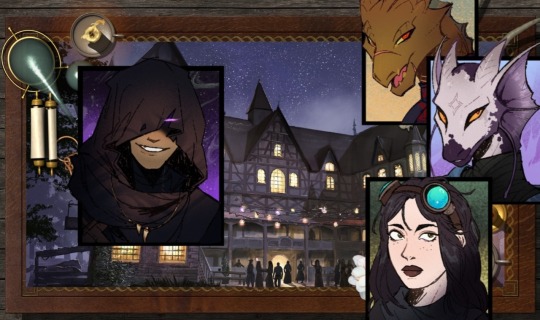

37 notes
·
View notes
Text
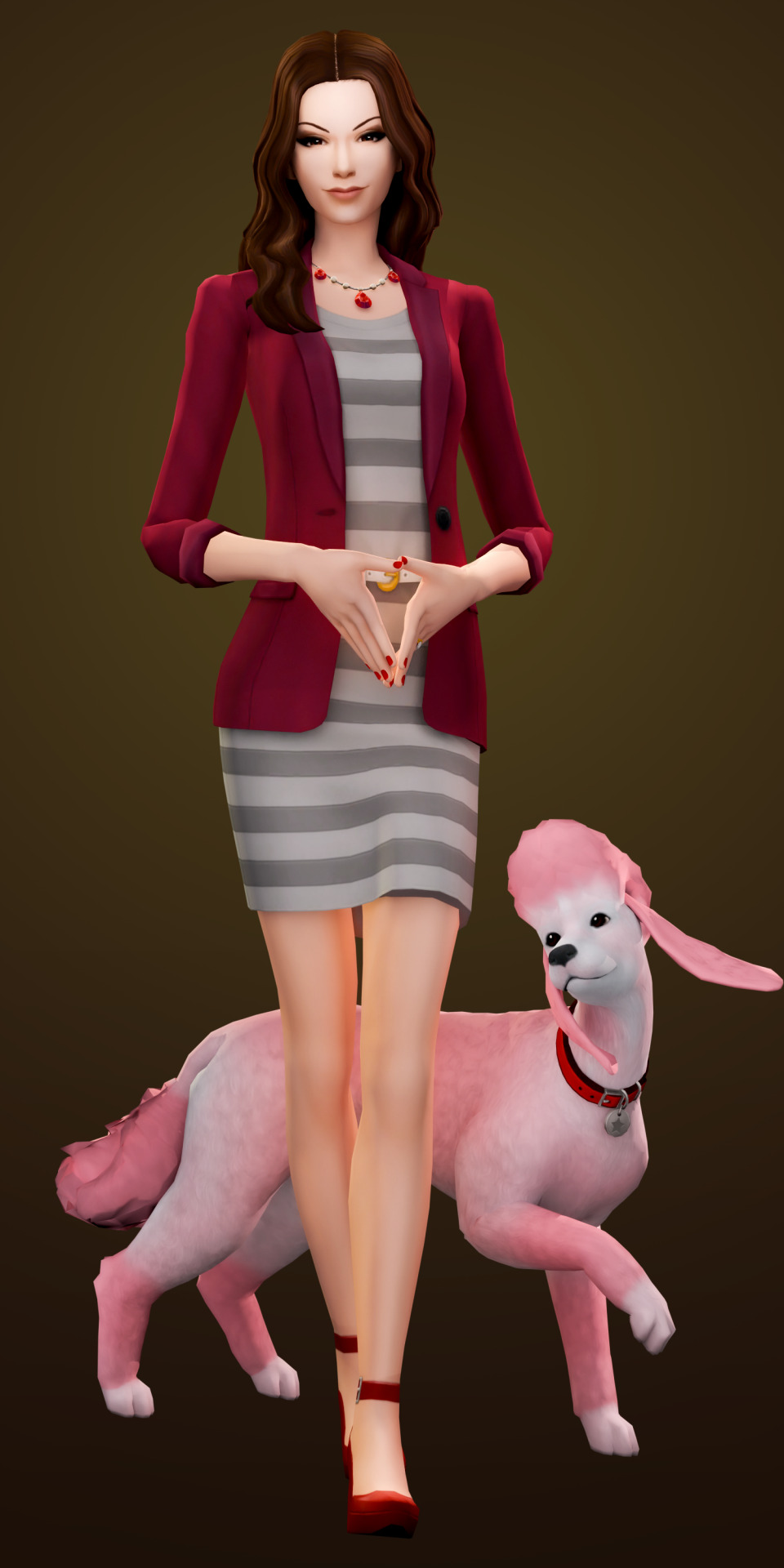
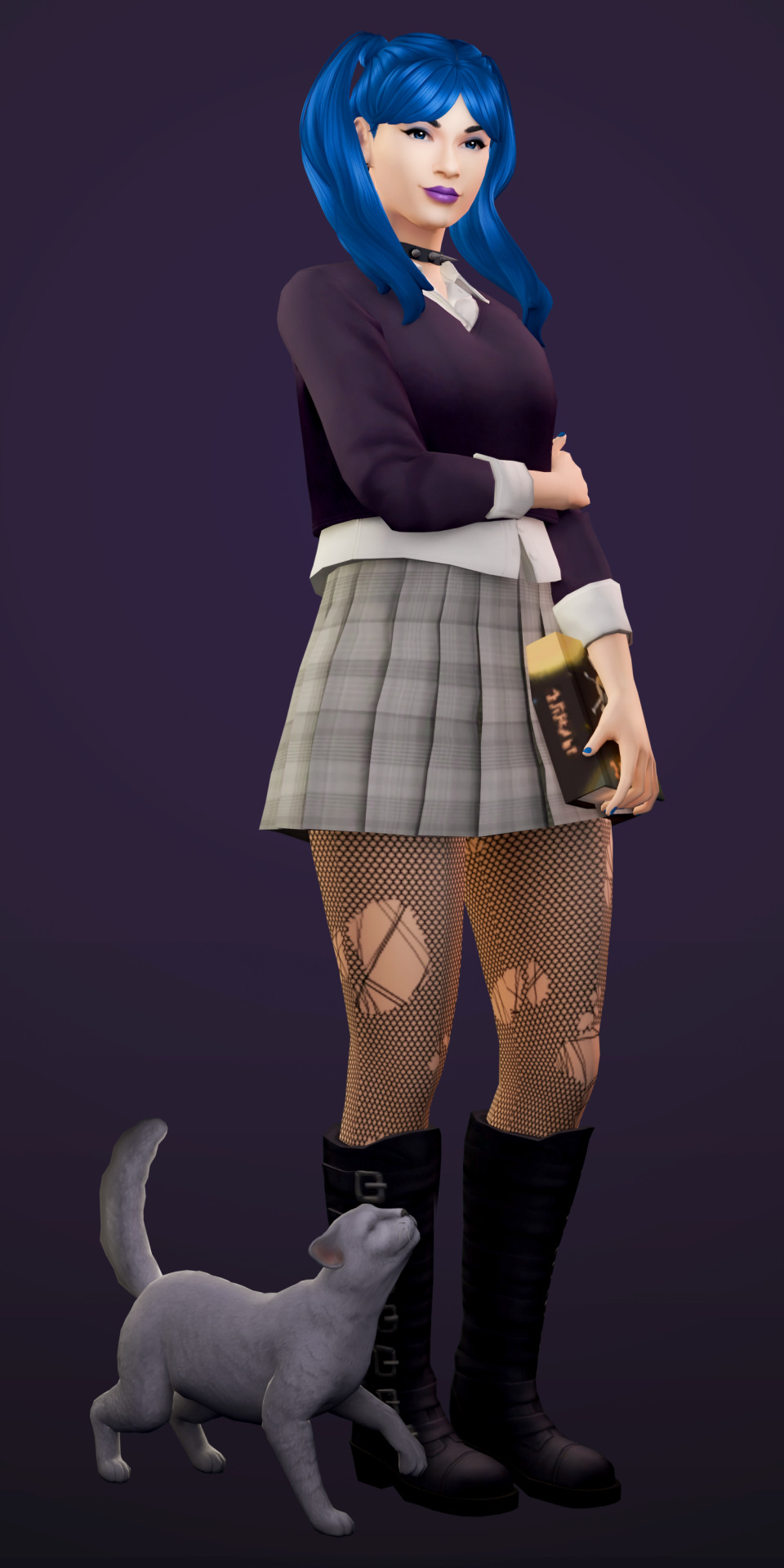
Jade Pingree is the all-business (and pretty rude) head of the Barkersville Companion Club.
Meredith is part librarian and part party girl. She’s serious during the day, and playful at night.
v - ramblings under the cut - v
I almost never see people talking about the characters from the Sims 2 Pets GBA. I mean. that's understandable. Sims 2 Pets for GBA was not only released two years after the DS was released, but it was also bad.
The Sims 2 Pets for GBA takes a lot of inspiration from the other GBA Sims games, with an isometric artstyle and a mixture of adventure elements and simulation elements. Howeverrr, the problem seems to be that it doesn't feel like it actually knows what to do with it.
The minigames are tedious and boring. Aforementioned minigames pay peanuts and rely on an NPC being in a specific location to do them. Characters have little personality; 70% of the dialogue in this game is completely exchangeable. There's no way to easily find NPCs that you need to find (read: phone call), even though they all have schedules and move all the time. The game doesn't keep track of missions. There's like three different kinds of burglars, and there's no way to stop them from coming to your house (what the fuck). Training your pets is so tedious and repetitive and yet everything else feels like a distraction from it. You can randomly, and frequently, get sick, from fully cooking your food with eight levels of cooking skill and using good kitchen items. Everything breaks down and is dirty all the time. Eating dog food is safer than cooking. This game is having me eat dog food because just cooking feels like a risk. And there's just so much more that annoys me about it.
Okay, I'm done complaining. There's not much to compliment about the game. It does have its charm but wears off as the tediousness of all of its various mechanics settles in. I mean. I'd like to know more about the characters, but also... I don't care.
I really wanted to make Jade. Unlike nearly every other character, she does, actually, have a personality. Even if it absolutely sucks. Meredith is my favorite character in the game. I can't explain why, but her design is neat and she seems really nice and likable. I was considering doing more (read: Elza and Hugo) but after I finished these two I. couldn't be bothered.
I feel as if Meredith brings the Blue Hair and Pronouns to Barkersville. She also has this kind of warmness that I haven't really gotten from other characters in this game. And I believe she's close with Kirk (... Carbon?). I'd suspect they were dating, as they both have positive reactions when they mention each other and I caught them going on a Graveyard Date at 1:00 AM. But when I talked to Kirk he said even though he's with a girl, he thought Celina was hot. So I can only make one conclusion: leave your shitty boyfriend, Meredith!!!
And on Jade: She's definitely on the Barkersville HOA (and Barkersville definitely has one!). She's just that kind of demon. It's mentioned that the Pingree's are a wealthy family. So, I don't think she has a job. Instead, she just torments her community with her influence.
Anyways. I don't actually know anything else about these characters beyond this. So. Um.
I had a lot of fun making these; I'm planning on doing something similar to this for all the Sims 2 GBA characters. I remade them all a few months ago, wanted to do renders to show them all off, and I want the excuse to write things like this about every single character. :) (and. I tried to do them all at once. but um. hm. that's just a little too much.) It'll take a while to actually finish anything w/ that because i need to experiment with format. I gave some of them outfits in other categories than 'everyday,' so I'm thinking about rendering those out, butttt that's up in the air.
#the sims 2 pets gba#meredith crumbie#jade pingree#sims 2 pets gba#sims 4 cas#sims 4 render#i got (to learn how) to use light linking for these :3#so both sims + their animals are all actually lit completely independently!#i love unrealistic lighting. unrealistic lighting is my passion.#absolutely abysmal on rendering speed though. god damn.#sims handhelds#tsq#simspics
15 notes
·
View notes
Text
Noctuary coming to PS5, Switch in 2025 - Gematsu

Game Source Entertainment will release PlayStation 5 and Switch versions of Gratesca Studio-developed isometric action adventure game Noctuary in 2025, the company announced.
Noctuary first launched for PC via Steam on November 28, 2023.
Here is an overview of the game, via its Steam page:
About
Colorful and splendid! An intriguing fairy tale of illuminators!
Alina Nightsong – One of the two protagonists and Fancia’s partner from the Earthcaress Beacon, is passionate…but a bit slow on the draw?
Fancia Dream – One of the two protagonists, the younger sister in the Dream family. Works hard to pass the Arboranger test to fight Darkritters.
Noctuary is a dual-protagonist visual novel. Players can play the role of the duo, Fancia Dream and Alina Nightsong who have dreams of “becoming Arborangers who protect and serve everyone.” Travel through the fairy-tale-like world as the duo, experience their lively daily adventures, and gradually encounter the life story of a mysterious girl who came down from the sky. Meanwhile, don’t forget to fight against the ever-present monsters—“Darkritters!” These dangerous enemies threaten the life of Illuminators constantly. Sharpen your fighting skills, defeat ferocious monsters and ensure peace in your community!
Practice Your Fighting Skills in Marvelous Battles
During your adventure, you will fight against various enemies. You can defeat them with a cascade of powerful combo attacks! The two main characters master different skills and present various fighting styles, which allows you to win a battle in whichever method you choose. Switch between the two girls in battles to cope with enemies’ attacks and finish them off with the powerful On-field Switch skill and the Synergy.
Support Your Favorite Protagonist and the Choices Your Make Will Impact the Ending of the Journey
You will venture into this dreamy world of Aborteria through the lenses of Illuminators. Intriguing character performances, original and melodious music, high-definition game scenes and character images… All this will make your gaming experience unforgettable.
Explore the Sophisticated “Blessing” System
The friendships and blessings you harvest along the journey will strengthen you in battle. Feel free to combine the “Blessing Petals” that are embedded with features of different characters to customize your battle style. In addition, there are many other well-designed cultivation systems that are ready for you to explore!
Watch a new trailer below.
Gameplay Trailer
English
youtube
Japanese
youtube
Traditional Chinese
youtube
3 notes
·
View notes
Text
DIMMADOME OF DIMMADALE
Hey. I was just talking about more gamey suggestion-based comics, and here we are, with another one of those. This one’s probably the most game-like of them all, and also, maybe the best one of them all? Depends on the other sleuthlikes, I guess. What I’m trying to communicate here is, I’ve been looking forward to this one.
For starters, this isn’t your typical, ordinary, average sleuthlike with a front-on perspective or isometric perspective. No, this is from a TOP-DOWN perspective, which easily sets it apart. There’s also the coolest detail of them all; the fact that there is, in fact, seemingly for no other reason than it being a cool feature to have, a mini-comic where the typical MSPFA face usually is. Which is just. Absurdly cool. Did I mention that I like it when there’s details like that in a comic, where it uses the website itself as part of its narrative design? Because I like it when that happens.
What I think this comic does very well for the suggestion-based gamey comic is that it realizes, rightfully so, that the game doesn’t have to be fixed by the time you start. In other words, you can add on as many ridiculous mechanics, meters and stats to track as you go along, which means that this comic is also a master of “Yes anding” the audience. It might refuse to do a certain command, but that does not mean that that command has been in vain, for it usually just means another system has been tacked on to what, if it were real, would be the ridiculous roleplaying system ever invented. Or like, in one of the commands, we get the classic “hey what if you kissed this other character” command everybody loves. So of course, the intentions of the commander was probably for this to be like, a romantic kiss, but the comic twists it into being a platonic kiss, because it can do that now. And now, worldbuilding has been built off the back of twisting a command as a twisting of subversion. I’ve used the word “twist” so many times I think I have lost count, twisting it’s meaning until it’s been pulled right off of it. Moving on.
OH SHOOT. THERE’S BANJO MEGALOVANIA IN THIS. OH SHOOT THERE’S REALLY COOL LIKE…Pointillism Environments in this? Hey uh I’m starting to think this might be peak. Okay yeah I’ve been convinced this is peak. If this isn’t the best one of all the Gamey Sleuthlikes, then I am *very* excited to see what could possibly top this.
Random stray note I guess: I love how many people in this are from the country and thus have Texan accents it’s great. That’s all I have to say.
4 notes
·
View notes